Sales package
Handset
Battery (BP-6MT)
Charger (AC-5)
Wired stereo-headset (HS-43)
USB data cable (CA-101)
TV cable (CA-75U)
microSD memory card (2 Gb)
Positioning
The market is now witnessing a unique situation when Nokia has three “all-in-one” devices on offer, retails them for pretty much the same money, yet packages these solutios with different features. In Europe you will be able to grab them for:
Nokia N95 – 480-500 Euro;
Nokia N82 – 450 Euro;
Nokia N81 8Gb – 430 Euro;
The Nokia N82 seems somewhat odd, however –it wedges into the Nokia’s otherwise consistent range and then provokes a natural question – Is there any real need in this phone? But the answer is right on the surface, you just need to take a better look around to figure out that the N82 is in fact strikes back at Sony Ericsson’s flagship – the Sony Ericsson K850i. This is what Nokia was set to do – roll out a direct rival for the K850i with comparable price tag and an edge in the form of S60. Speaking in favor of this guess is the fact that only now does a Nokia-branded device employs the bundled motion sensor for auto menu rotation not only in the camera application. The N82’s Xenon flash is another tribute to its imaging department. So, these two phones share a whole lot of features, plus the Nokia has hastened to release the N82 into the wild, which is not exactly typical of this company – all these facts seem to add up. The Finnish manufacturer had to launch its solution before the Christmas season and trip up the Sony Ericsson K850i. Hard to say for sure, but as I see it, the company has coped with both goals.
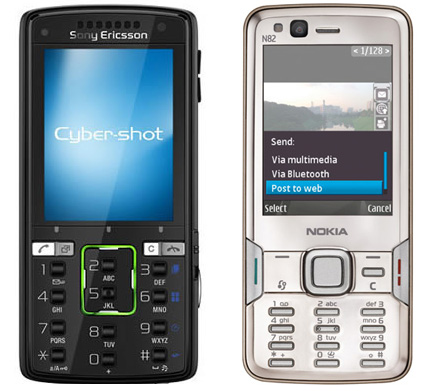
The calls the audience this handset is aimed at “Technology/Style Leaders”, which is a target group characteristic of the NSeries in general – the Nokia N73, which was rivaling the Sony Ericsson K800i a while ago, also came in to appeal to this segment. Obviously, the company is trying to capitalize on the N73’s success by positioning its latest and greatest N82 as a decent replacement for the former – and, well, this is pretty much how the things stand.
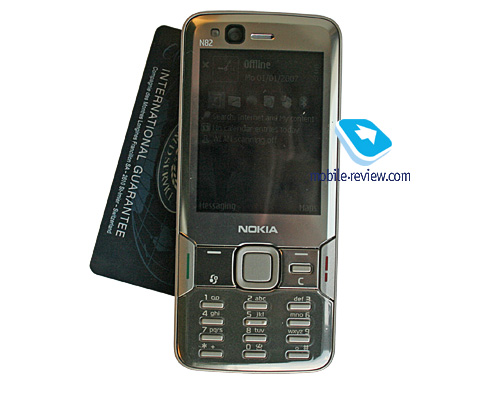
On the other hand, this phone focuses on the imaging department – its N-Gage functionality, as well as default applications for the latest generation of S60-powered handsets, only indicate that this is another “do-it-all” offering with knack for photography.
This model is designed for those who still haven’t got a Nokia N95 in their pockets for some reason, yet need a pretty good phone with a potent camera onboard. Also, all candy-bar style buffs will feel content with the N82, since it is the handset’s very conventional design that seems to be quaint for this end of the NSeries.
Its rushed release also indicates that the model will be all the range pretty soon – its price curve will match that of the Sony Ericsson K850i, ensuring some serious rivalry between the two.
The group of consumers looking for a decent cameraphone won’t find the choice between the Nokia N82 and the Nokia N95 8Gb particularly easy, even those the junior model trumps its 8Gb sibling only with the form-factor, lens cover and xenon flash –its image quality is pretty much in line with the N95 8Gb, and all hardware specs haven’t undergone any revamp.
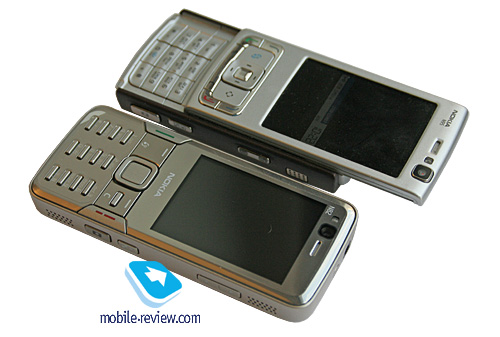

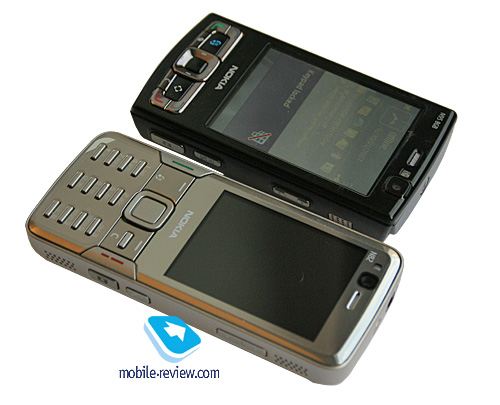
Design, size, controls
The N82 is housed in a candy-bar type design with average dimensions for its class – 112x50.2x17.3 mm, 114 grams. However when we met it in person, it seemed somewhat on the chubby side, the same impression was delivered by Sony Ericsson K850i, by the way. On the other hand, the phone is very pocket-friendly. But it is not “friendly” enough to be carried on a neck strap, probably some will use an arm strap at best.

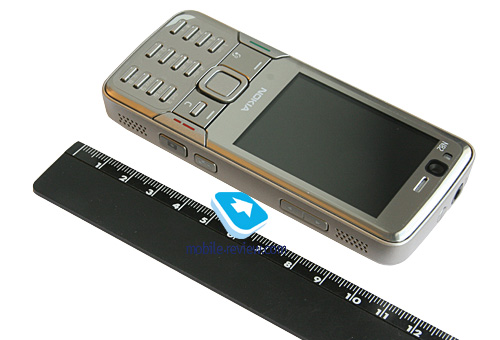
Display
The handset comes equipped with a 2,4-inch QVGA (240x320 pixels) display, capable of showing up to 16M colors, presenting you with a quite bright picture that remains visible in various environments.
Facing off the N82’s display against the Nokia N95, you won’t see any real supremacy of the latter in your daily routine, but when it comes to the Nokia N95 8G and its 2,8-inch behemoth of a display, the 0,4-inch difference won’t pass unnoticed. Generally, the N82’s display fares well. The display accommodates up to 8 text and up to 3 service lines. In some modes, though, you may get up to 14 text lines. All fonts are sharp and easy to read.
No protective glass screen is mounted on the N82’s display.
Keypad
One of the most popular questions asked about the N82 is whether its keypad is any good. Indeed, its buttons are smallish, and the shapes aren’t exactly conventional. In fact, this element somewhat reminded me of the Sony Ericsson’s solution, and I don’t think this is a pure coincidence – they wouldn’t have had any troubles squeezing normal numeric buttons on this area, but for some reason, Nokia had dumped its standard keypad style.
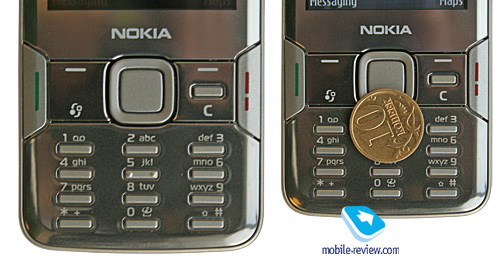
Battery
The handset utilizes a 1050 mAh Li-Pol battery (BP-6MT). The N82 is rated for 5 hours of talk time and 225 hours of standby. Music time – up to 10 hours, max quality video recording – up to 110 minutes, video playback – up to 200 minutes.
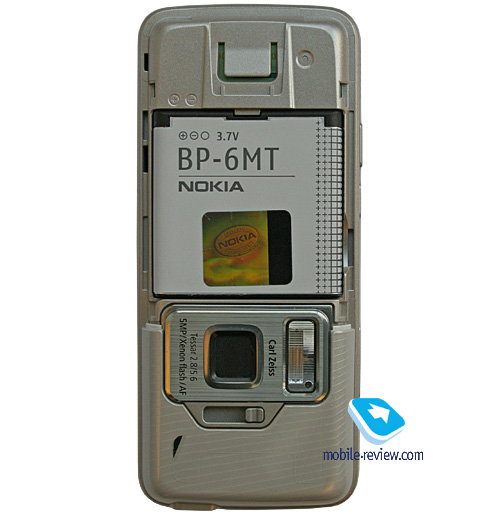
Memory
The device comes equipped with 128 Mb of RAM, after first launch you will get around 90 Mb of free memory at your disposal, which is enough for running a dozen of applications and browsing “heavy” web-pages – the word “slow-down” is definitely not in the N82’s vocabulary.
The user has almost 100 Mb of storage available, where can store any data.
The N82 deals with microSD memory cards (hot-swappable), the phone comes packaged with a 2Gb unit. There are no restrictions as far as memory card’s size is concerned – our handset easily identified a 4Gb card.
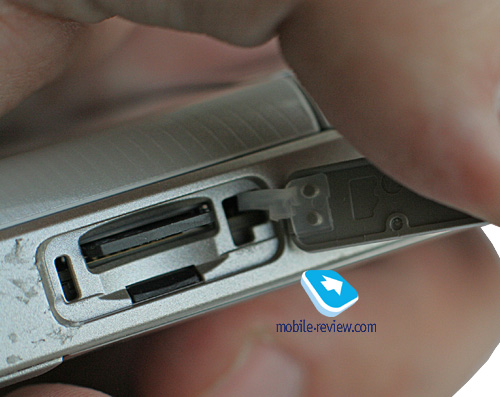
USB, Bluetooth, Wi-Fi
USB. The handset comes in with USB 2.0 support (data transfer speeds – 600-650 Kb/s, whereas the Nokia N95 offered up to 900-950 Kb/s), upon a successful PC connection you can choose one of the following modes:
Data Transfer (Mass Storage USB) – memory cards is available, no drivers required, as your OS identifies the handset automatically.
PC Suite – used for device management via Nokia PC Suite, enables all features of the phone, data backup etc.
Image Print – no explanation required.
Media Player (MTP protocol) – synchronizes data with Windows Media Player.
Bluetooth. The smartphone sports EDR-enabled Bluetooth 2.0 alongside the following profiles:
A2DP
AVCRP
BIP-ImagePush
DUN-GW
FT-Server
HandsFree-AG (1.0)
Headset-AG
OBEX
OPP-Client
OPP-Server
SIM Access-Server
The top speed you can get with the N82’s Bluetooth connection is around 100 Kb/s. We also tested its A2DP profile in pair with the Sony Ericsson DS970 headset, which worked just fine – we managed our play list, skipped within tracks and adjusted volume seamlessly, however we couldn’t make current track’s title show up on the N82’s display.
Wi-Fi. This handset comes armed with Wi-Fi (IEEE 802.11 g) support. All security standards are supported: WEP , WPA , WPA 2, with other advanced settings available. The device supports Universal PnP standard (UPnP), which is the successor to the wired standard PnP. With its help, along with Wi-Fi, you can send slides to a TV, music to a stereo system, and photos to a printer. In a certain sense UPnP is like an add-on to the infrastructure (Wi-Fi, for example) in the form of Bluetooth-esque services, so this looks more like a software upgrade. The sales package includes Home Media Server, which allows connecting the N82 through your home Wi-Fi network to a desktop PC.
There is also a Wi-Fi wizard available in the N82 – it can keep looking for enabled networks in the background mode and tap into them.
VoIP
This feature has been carried over from the Eseries, as it retains just the same settings pool and is pretty easy to manage. The SIP protocol enables you to make calls bypassing your GSM-carrier (though you will still need an IP-telephony operator). The best thing about this solution is that you can employ Wi-Fi networks to reduce your calls-related expenses. If you would like to have a Skype-esque application on your handset, the Fring or TruPhone are the way to go.
Camera
The N82’s camera module has been carried over from the Nokia N95, and its major trump is the xenon flash. The edge it has over the standard LED unit can be seen already today – in fact, it all comes down to a couple of scenes, snaps taken in the dark and indoors. Sony Ericsson was the first maker to adopt this type of flash, and the K850i, in addition to its xenon unit, boasts a LED flash gun, which is the best way to go for a mobile device, ensuring high-quality of images you get even while in photography-unfriendly environments.
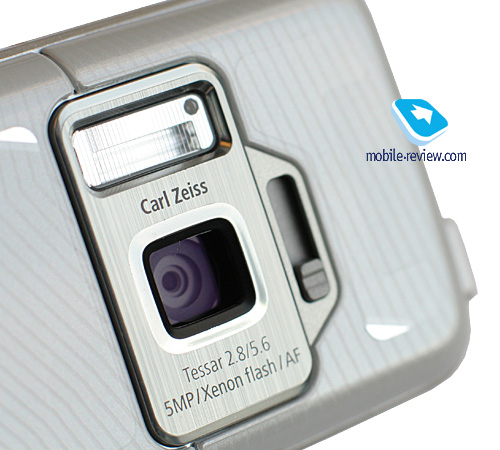

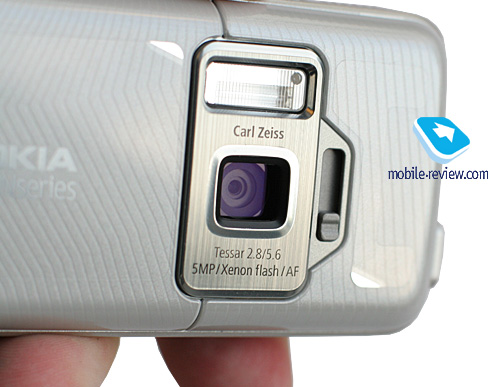
N-Gage and gaming department
Much like the Nokia N81, the N82 comes preinstalled with the N-Gage section. When the service is released into the wild, however, this application will be available for download for the Nokia N95 as well, so there is no real difference between these two in this sense. The N82 edition ships with three games –Space Impact, Asphalt 3D, Fifa07, all of them are demos, with full versions retailing for 20 Euro and more.
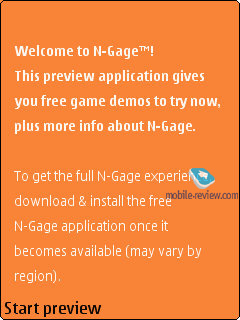
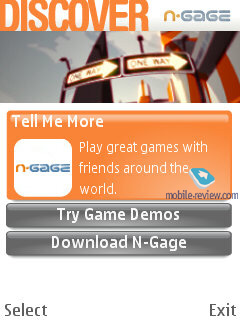
The handset comes with no buttons for games, even though its music controls could well double as gaming-minded keys. In my opinion, it is not very consistent of Nokia to put the Snake and some other games into a separate menu item, which somewhat fragments the handset’s gaming experience – some are N-Gage branded, some not. It is a clear misstep in the concept, bringing about ever more complexity into the phone’s menu.
Preinstalled applications
The Nokia N82 comes armed with LifeBlog – application that gathers all your multimedia content in one place and then allows you to browse it via a timeline, which is interesting in a certain sense, but as far as I know very few people actually find some use for this feature, while others prefer employing the phone’s Gallery or the File Manager.
Video Center– enables the user to subscribe to various channels offering an assortment of video clips, including YouTube’s mobile version. All videos get uploaded onto the device, so that you will be able to watch them whenever you want. You can expand clips to full screen in the landscape mode, plus there is the portrait mode available with the N82. The best way to upload clips is via home or office Wi-Fi networks.
QuickOffice comes in its shrunk edition. Specifically, with the version found in the Nokia N82 you won’t be able to edit office documents. To go beyond the Read Only mode you will need to pay extra money.
Adobe PDF – allows reading PDF-files, no complaints about the application.
ZIP – enables you to extract files from archives or create new archives.
Barcode – reads bar codes, as its name suggests. Almost of no real use these days, though.
Competition
Taking other Nokia’s models out of the brackets, the N82 openly clashes only with the Sony Ericsson K850i, matching the former in terms of price and feature pack. Let’s take a look at the table with all primary specs of these two phones:
Nokia N82 Sony Ericsson K850i
Size, weight (mm, grams)112x50.2x17.3, 114 102x48x17, 118
Display 2.4 inches, TFT, QVGA, 16M 2.2 inches, TFT, QVGA, 262K
Bundled memory 100 Mb 40 Mb
Memory cards microSD microSD orM2
Battery Li-Pol, 1050 mAh Li-Pol, 930 mAh
Average battery time 1.5-2 days 2-3 days
MTP mode on USB connection Yes Yes
3,5 mm audio jack On the casing Adapter required
Camera 5 Mpix, CMOS, lens cover 5 Mpix, CMOS
Flash Xenon Xenon + LED
Video record VGA, up to 30 FPS QCIF, 15 FPS
Stereo-speakers Yes No
Platform S60 3td Edition FP1 A200
Price 450 Euro 450 Euro
Putting these two handsets up against one another, you will definitely wonder how many things they actually share. All queer aspects of the Sony Ericsson K850i have been addressed in the Nokia N82 and deliberately put into the limelight. As a matter of fact, apart from throwing the camera module that is just as good or even a tiny bit better (still wrangled about), Nokia also kitted it out with the lens cover, bigger memory card shipping in the box and TV out for recorded video. Additionally, the video quality is always quite decent. The Sony Ericsson K850i’s drawbacks, or, let’s put it this way, odd features are: different ergonomics of the navigation pad and the lack of hardware soft-keys. All these sacrifices have been made so as to trim the phone’s length down. But does its size really make this much of a difference, or having a conventional keypad under your fingertips is a more important factor? Hard to tell.
One thing is for sure – while yesterdays Sony Ericsson’s imaging-heavy flagships were a step ahead of Nokia in terms of functionality, design and price-quality ratio, these days Nokia has the lead. If you look at the sales packages of these two phones, the Nokia N82 is on the richer side, also it packs a lot of extras under its hood, which is also the amenity we can’t overlook. Speaking in favor of the K850i are its longer battery life, marginally smaller dimensions and probably design for some. And undoubtedly, the love and loyalty of this brand’s followers. It is the first occasion when Nokia has managed to deliver a direct competitor to a Sony Ericsson’s imaging flagship in time. If you try to assess every model’s market performance in terms of sales, even now it’s clear that Nokia comes out victorious – there is such a vast difference between the companies size-wise.
Impressions
Don’t expect to find here any low-down on the N82 in this section, at least for now – we had to put this phone through its paces in several sittings, on top of that, every unit we had hands-on sessions with was different. Though, we will get our mitts on a commercial unit pretty soon, and as soon as it arrives, we will update this review, and, for the time being, let us call this a ‘preview’.
Has Nokia hit the bull’s eye with this model? It is absolutely safe to say this handset will appeal to the masses and will be a truly sought-after offering – the N82 definitely has what it takes and just like the Nokia N73 a year ago, it is on its way to the title of the most affordable and decent Nokia-branded imaging-minded solution. Its music department is no different from the Nokia N95 8Gb, meaning that it proves to be somewhat inferior to the Nokia N81. Still, your music experience with the N82 won’t be irritating or dismal. Missing remote control from the sales package is another hint at the handset’s true positioning.
Given its current retail price of 450 Euro, the N82 is up against the Sony Ericsson K850i alone. Which one to go for, I hear you ask? It will be one tough decision for you, better listen to what your experience of playing around with either of the phones tells you. For the owners of the Nokia N95, the N82 won’t break any new ground – by and large it is the N95, yet with some of its shortcomings mitigated and more RAM onboard.
Shedding some light on myths and rumors circulating around the web on an impending music-savvy edition of the N82 carrying 8Gb onboard, I have to say this is very unlikely in view of the handset’s positioning. It already has a rival, which can only dream of 8Gb of storage. Looking at Nokia’s range you may well come to a conclusion that the arrival of a handset like this retailing for 70 Euro would be fine if only they didn’t have the Nokia N95 on offer. Which won’t happen for at least 7-8 months to come. Just like the Nokia N73, the N82 doesn’t have any sort of 8 or 4 Gb vartiations.
review @ mobile-review.com
2 comments:
Where did you find the N82 for 450 euros??
I think this article cold be written better... the autor compares the N82 very often with the K850i, but on the other hand I can't read one word about basically features like gps ...
greets marcel
Post a Comment